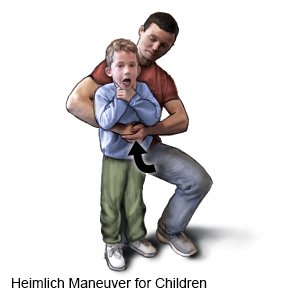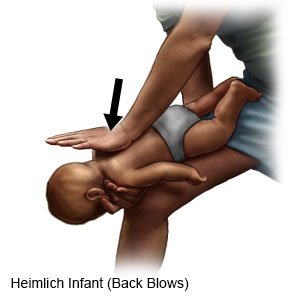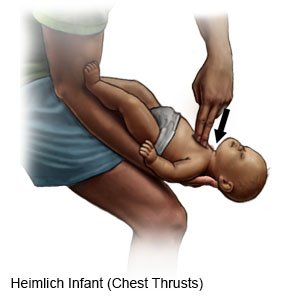How to Perform the Heimlich Maneuver
Medically reviewed by Drugs.com. Last updated on Apr 6, 2025.
What is the Heimlich maneuver?
The Heimlich maneuver is a procedure used to help a choking person who is conscious but not able to talk. The Heimlich maneuver pushes air out of the person's lungs and makes him or her cough. The force of the cough may then move the object out of the airway.
What are the signs that a person has a blocked airway?
- Bright red or bluish face
- Grabbing of the throat
- Not being able to cough forcefully
- Trouble speaking
- Wheezing or a whistling sound when trying to breathe
What do I need to do before I start the Heimlich maneuver?
- Ask the person if he or she is choking.
- If the person nods yes, ask if he or she can speak.
- If the person cannot speak, call your local emergency number (911 in the US) . Perform the Heimlich maneuver on the person until help arrives.
- If the person can speak, this means the airway is only partly blocked. Tell the person to try and cough to push the object out.
How do I perform the Heimlich maneuver on adults and children older than 1 year?
- Wrap your arms around the choking person's waist. Bend the person slightly forward at the waist.
- Make a fist with one of your hands. Place the thumb side of your fist between the person's belly button and the lowest part of his or her ribs. Do not put your fist on the ribs.
- Put your other hand over your fist. Press your fist into the person's abdomen with a quick inward and upward thrust. Repeat the quick thrusts until the object comes out. If the person vomits, lay him or her on his or her side to prevent the object from totally blocking the airway.
Use less force on a child than you would on an adult.

- Lay the person on his or her back on the floor if he or she is not conscious. Then start CPR if you have training and call your local emergency number (911 in the US) . Wait for help to arrive if you do not have CPR training.
Drugs used to treat this and similar conditions
Phazyme
Phazyme is used for endoscopy or radiology premedication, functional gastric disorder, gas ...
Ozempic
Learn about Ozempic (semaglutide) for type 2 diabetes treatment, weight management, cardiovascular ...
Alka-Seltzer Anti-Gas
Alka-Seltzer Anti-Gas is used for endoscopy or radiology premedication, functional gastric ...
Maalox Anti-Gas
Maalox Anti-Gas is used for endoscopy or radiology premedication, functional gastric disorder, gas ...
Aluminum hydroxide/magnesium hydroxide/simethicone
Aluminum hydroxide/magnesium hydroxide/simethicone systemic is used for gas, GERD, hiatal hernia ...
How do I perform the Heimlich maneuver on a pregnant or overweight person?
Wrap your arms under the person's armpits. Place your fist on the center of the person's breastbone. Be sure your fist is not low on the breastbone, or off to one side on the ribs. Place your other hand over your fist, and do quick pushes. Do this until the object comes out or the person becomes unconscious.
How do I perform the Heimlich maneuver on a choking infant younger than 1 year?
- Hold the infant face down, with the head slightly lower than the feet. Support the infant's jaw and head with your hand. Support the infant's weight with your knee if you are sitting. Use your forearm if you are standing.
- Give up to 5 blows on the infant's upper back, between the shoulder blades. Use the heel of your free hand to do this. If you see an object come out of the infant's mouth, stop the back blows.

- Sandwich the infant between your arms and hands, and turn the infant face up. Support the head and neck with your hand. The infant's head should be held slightly lower than the feet.
- Give up to 5 chest thrusts with 2 fingers. Place your fingers on the lower half of the infant's breastbone. Be sure your fingers are not off to one side, or at the bottom of the breastbone. If you see an object come out of the infant's mouth, stop giving the chest thrusts.

- Repeat all steps until the object comes out of the infant's mouth. If he or she becomes unconscious, call your local emergency number (911 in the US) and begin CPR. Ask for more information about performing CPR on infants.
How do I perform the Heimlich maneuver on myself?
If you can breathe and talk, cough hard to try to force the object out. If you cannot talk, cough, or breathe, do the following:
- Call your local emergency number (911 in the US). Set the phone down while you perform the Heimlich maneuver. Do not hang up the phone.
- Make a fist with one hand. Place the thumb side of your fist between your belly button and the lowest part of your ribs. Do not put your fist on your ribs.
- Put your other hand over your fist. Press your fist into your abdomen with a quick inward and upward push. Repeat the quick pushes until you are able to spit out the object.
- If you cannot get the object out, press your upper abdomen over a hard, flat surface. The back of a chair, side of a table, or porch railing may work. You may need to do many hard, fast pushes against the surface to clear your airway.
What can I do to help prevent choking?
- Cut food into small pieces and chew slowly and well.
- Do not talk or laugh while you chew or swallow food.
- Do not give medicine in tablet form to children younger than 4 years or anyone who cannot swallow well.
- Do not give foods such as peanuts and popcorn to small children or anyone who cannot chew well.
- Do not let young children play with toys small enough to put in their mouths. Be aware of choking hazard warnings on toys.
Care Agreement
You have the right to help plan your care. Learn about your health condition and how it may be treated. Discuss treatment options with your healthcare providers to decide what care you want to receive. You always have the right to refuse treatment. The above information is an educational aid only. It is not intended as medical advice for individual conditions or treatments. Talk to your doctor, nurse or pharmacist before following any medical regimen to see if it is safe and effective for you.© Copyright Merative 2025 Information is for End User's use only and may not be sold, redistributed or otherwise used for commercial purposes.
Further information
Always consult your healthcare provider to ensure the information displayed on this page applies to your personal circumstances.
